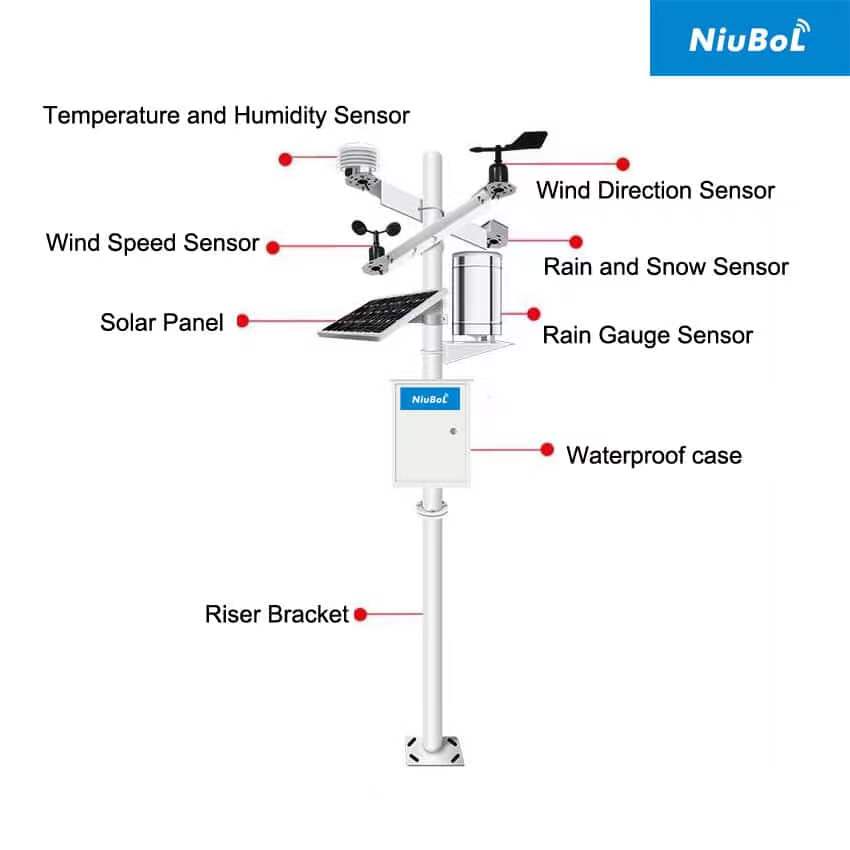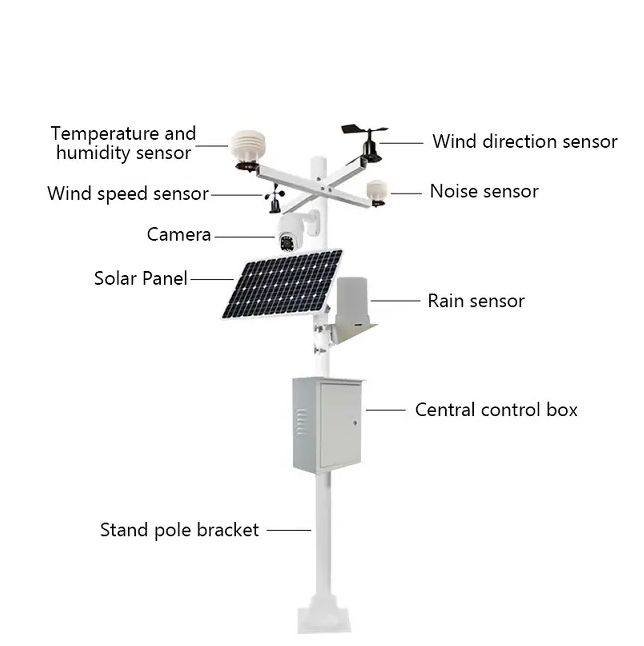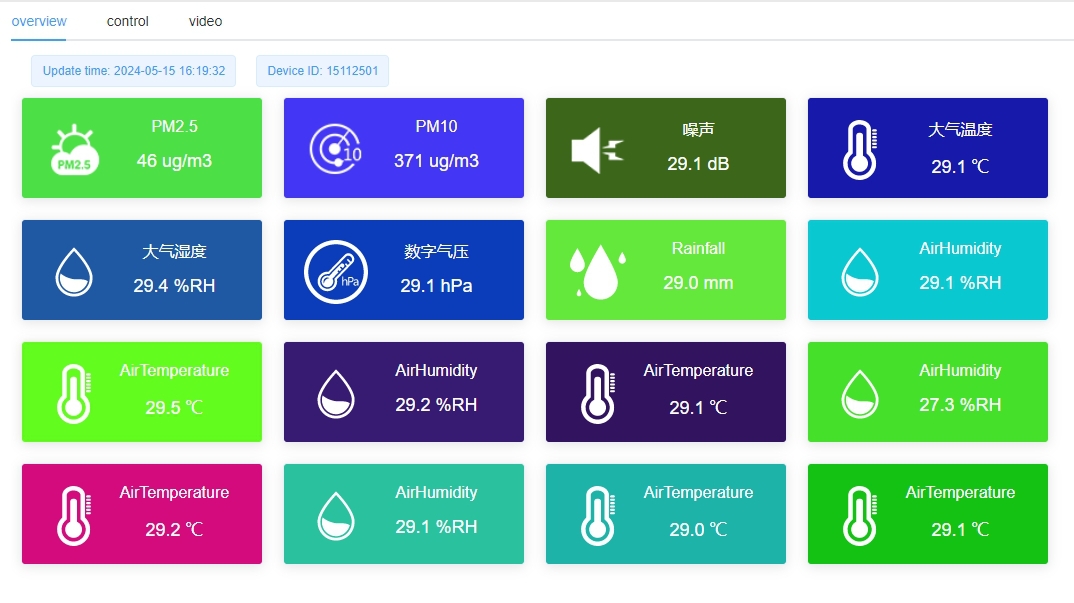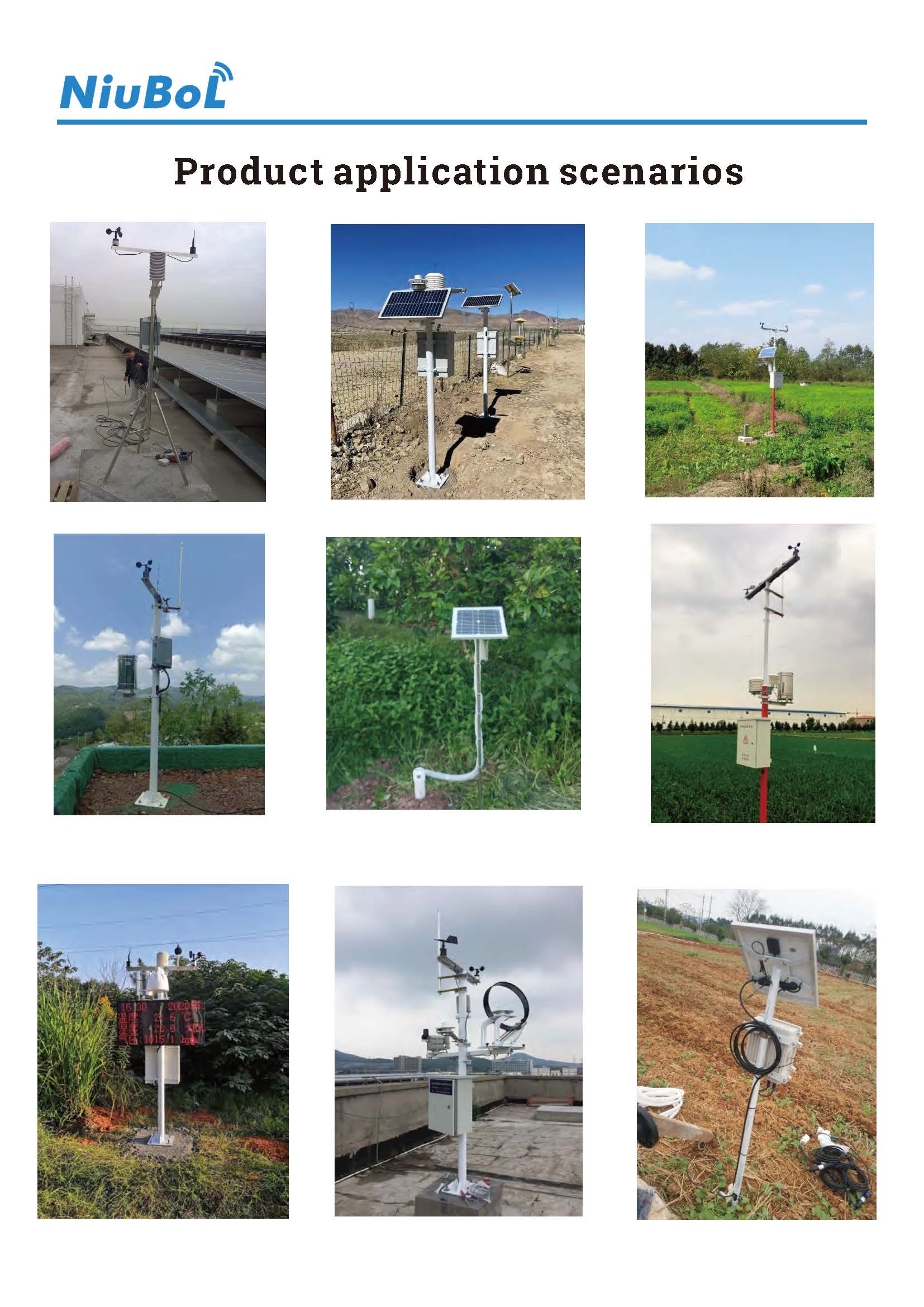

— Products —
 Consumer hotline +8618073152920
Consumer hotline +8618073152920 WhatsApp:+8615367865107
Address:Room 102, District D, Houhu Industrial Park, Yuelu District, Changsha City, Hunan Province, China
All products
Multi-element weather stations monitor meteorological parameters in real time by integrating a variety of sensors to provide accurate data for weather forecasting, agricultural production, scientific research and so on. Their sensors include wind speed, wind direction, temperature, humidity, barometric pressure, etc., each of which plays an important role in weather forecasting, agricultural production and environmental protection. The role of these weather stations is reflec···
Tel/WhatsApp:+8615367865107
Email:Arvin@niubol.com +Nearly 100 partner company in more than 68 countries. We are committed to providing high-quality, practical products to meet your needs and help you solve problems.Product Details
Weather Station with Multiple Sensors, also known as Multi-element Weather Station or Comprehensive Weather Station, is a multi-functional and fully automatic weather monitoring and warning system based on modern sensing technology and wireless communication technology. It can accurately and real-time monitor and record a variety of meteorological parameters, providing comprehensive and reliable data support for meteorological forecasting, agricultural production, scientific research, environmental monitoring and other fields. This kind of weather station is usually characterized by small size, light weight, easy installation and stable operation, which is suitable for meteorological monitoring under various environmental conditions.
The weather station is mainly composed of data collector, sensors, transmission system and power supply system. The data collector is responsible for collecting the data measured by each sensor, and sends the data to the monitoring center or cloud platform through the transmission system, so that users can view and analyze the data in real time.
 |  |  |  |  |
| Anemometer Wind Speed sensor | Wind direction sensor | Tipping bucket rain gauge sensor | Tipping bucket rain gauge sensor | Piezoelectric Rain Gauge |
 |  |  |  |  |
| Atmospheric Temperature Humidity air pressure Sensor | ultrasonic wind speed and direction sensor | 5 in1 Ultrasonic Weather Station Sensor | All-in-One Weather Station | 7 in1 Ultrasonic Weather Station Sensor |
 |  |  |  |  |
| Solar Radiation Sensor | Solar Radiation Sensor | Photosynthetically Active Radiation Sensor; | illumination sensor | Ultrasonic Snow Depth Sensor |
 |  |  |  |  |
| Noise measurement sensor | Carbon dioxide(CO2) sensor | PM2.5 and PM10 sensors | Visibility sensors | Soil Moisture Temperature sensor |
1. Wind speed sensor: Using wind cup or similar devices to sense the rotation of the wind, and calculating the wind speed by measuring the electrical signal generated.
2. Wind direction sensor: The rotation of the wind vane drives the internal circuit board to generate electrical signals to determine the wind direction.
3. Air temperature sensor: Used to measure the air temperature, usually realized by thermistor or thermocouple and other components.
4. Air humidity sensors: measure the amount of water vapor in the air, common types of capacitive, resistive and so on.
5. Atmospheric pressure sensors: use piezoresistors and other components to sense changes in atmospheric pressure and generate the corresponding electrical signals.
6. Solar radiation sensors: measure the light and heat energy from the sun, and convert the radiation energy into electrical signals through thermoelectric stacks or photoelectric components.
7. Rain gauge: used to measure rainfall, in various forms, such as tipping bucket type, laser type and so on.
In addition, other types of sensors such as negative oxygen ion sensor, optical rain sensor, solar radiation sensor, light sensor, CO2 sensor, PM2.5/PM10 particulate matter sensor, soil moisture sensor and so on may be included to meet the needs of different fields.

Introduction: Sensing wind speed through the rotation of the wind cup and converting the rotation into an electrical signal.
Role: Provide wind speed data, which is important for weather forecasting, wind power generation, aerospace and other fields.
Introduction: The wind vane rotates with the wind and drives the internal circuit board to generate electrical signals to indicate the wind direction.
Role: Provide wind direction information, help to understand the direction of airflow and wind speed changes.
Introduction: Using thermistors and other components to sense changes in air temperature.
Role: Provide temperature data, which is vital for weather forecasting, agricultural production, environmental monitoring, etc.

Introduction: Measures the amount of water vapor in the air through changes in capacitance or resistance.
Role: Provides humidity data, which is important for agricultural irrigation, indoor environmental control, etc.
Introduction: use piezoresistors and other components to sense changes in atmospheric pressure.
Role: Provide atmospheric pressure data, which is important for weather forecasting, climate research, etc., such as low air pressure usually heralds the arrival of bad weather.
Introduction: Convert solar radiation energy into electrical signals through thermoelectric stacks or photoelectric elements.
Role: to provide solar radiation data, for solar energy utilization, climate research, etc. is of great value.
Introduction: Measures rainfall by collecting rainwater and converting it into an electrical signal.
Role: Provide rainfall data, which is important for hydrological forecasting, flood warning, water resource management, agricultural irrigation and so on.

Function: Measure light intensity or photoperiod.
Role and value: Light data is important for plant growth, solar power efficiency assessment, and research on biological clocks and ecosystem responses.
Function: Measures the concentration of carbon dioxide in the air.
Value: CO2 data are essential for studies of the greenhouse effect, air quality monitoring, and management of greenhouse gas emissions from agriculture.
Function: Measures the intensity of ultraviolet light.
Value: UV data is important for skin cancer prevention, sunscreen product development, and research on ozone layer changes.
11. soil moisture sensor: Used to measure soil moisture content. Commonly, there are frequency-domain reflective and time-domain reflective sensors.
By integrating a variety of sensors, multi-factor weather station can monitor and record a variety of meteorological parameters in real time, providing comprehensive and accurate meteorological data support for various fields. These data not only contribute to the accuracy and timeliness of weather forecasting, but also provide an important reference basis for agricultural production, scientific research, environmental monitoring and so on. In addition, multi-factor weather stations have the advantages of easy installation, stable operation and low cost, which is an important part of the modernized meteorological monitoring system.
1. Improving the accuracy of weather forecasting: providing real-time meteorological data for weather forecasting.
2. Promoting agricultural production: helping farmers rationalize their farming activities and improve yields.
3. ecological environmental protection: monitoring environmental changes and providing data support for environmental protection.
4. Disaster early warning: timely detection of meteorological disasters, providing basis for disaster prevention and mitigation.
5. Scientific research: provide data for research in meteorology, geography, ecology and other fields.
In short, weather stations with multiple sensors play an increasingly important role in modern society, providing a strong guarantee for our life, work and development.

Summary
Weather stations are able to comprehensively monitor many aspects of the atmospheric environment through the multiple sensors they are equipped with, providing key data support for weather forecasting, environmental research, agricultural production, energy management, and so on. These data not only help us to better understand the natural environment, but also guide decision-making, improve the quality of life, protect natural resources, and meet the challenges posed by climate change. The continuous advancement of sensor technology in weather stations has led to more accurate and real-time data collection, providing strong scientific and technological support for the sustainable development of modern society. They play a vital role in areas such as weather forecasting, agriculture, aviation, navigation, scientific research and environmental protection.
Sensors & Weather Stations Catalog
Agriculture Sensors and Weather Stations Catalog-NiuBoL.pdf
Weather Stations Catalog-NiuBoL.pdf
Related recommendations
 Multi-Depth Soil Sensor RS485
Multi-Depth Soil Sensor RS485 TDR Soil Moisture Sensor
TDR Soil Moisture Sensor Pyranometer Solar Radiation Sensors
Pyranometer Solar Radiation Sensors Soil ph sensor
Soil ph sensor Tipping Bucket Rain Gauge
Tipping Bucket Rain Gauge Air Temperature and Humidity Sensor
Air Temperature and Humidity Sensor
Screenshot, WhatsApp to identify the QR code
WhatsApp number:+8615367865107
(Click on WhatsApp to copy and add friends)
